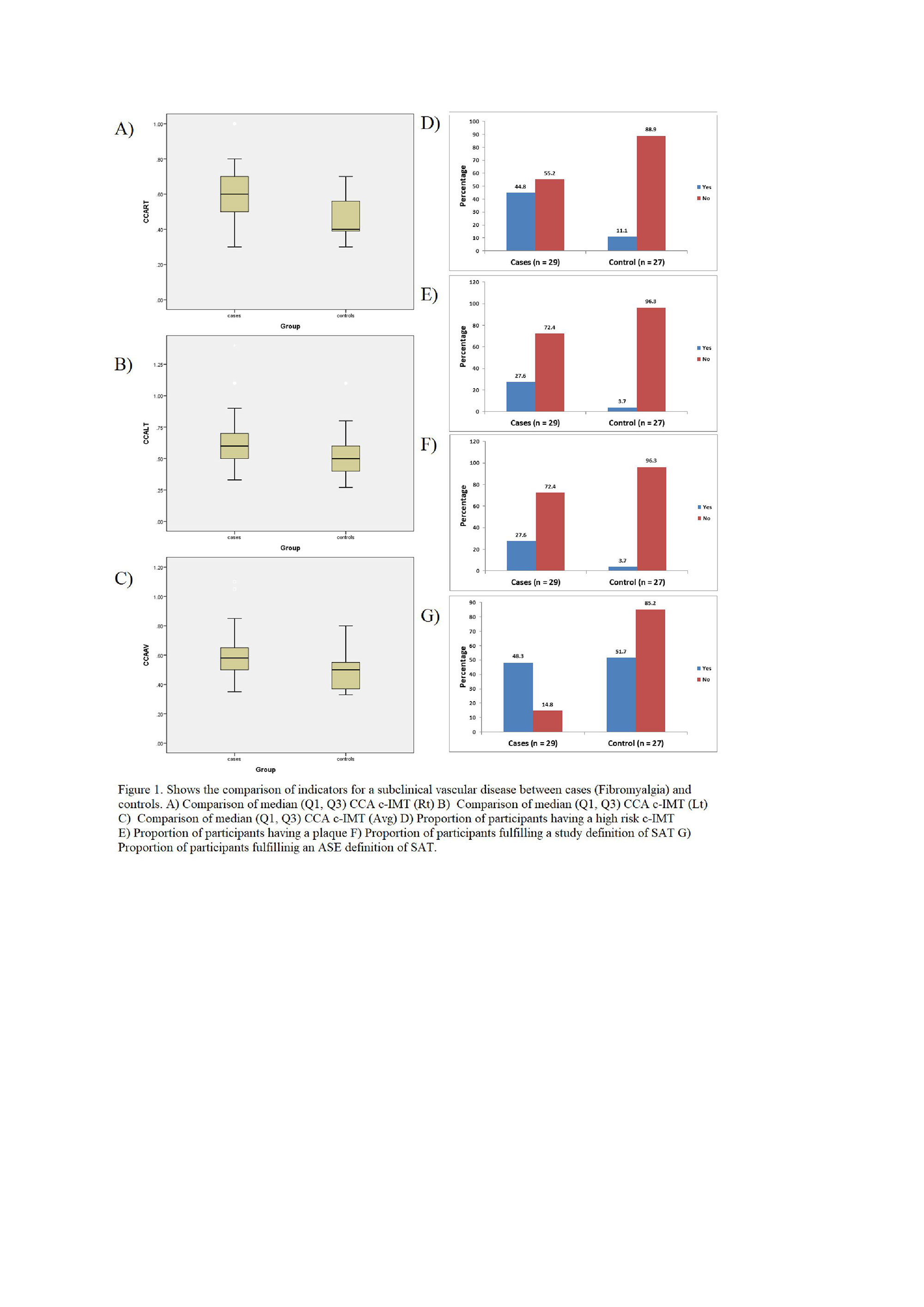Session Information
Session Type: Poster Session C
Session Time: 1:00PM-3:00PM
Background/Purpose: Fibromyalgia is known to be associated with cardiovascular events and mortality. We aimed to compare the prevalence of subclinical atherosclerosis (SAT), a surrogate marker for subclinical vascular disease between fibromyalgia and the control population.
Methods: We conducted a cross-sectional study between 1st September 2020 to 30th April 2022 at a tertiary care teaching hospital. All clinically diagnosed fibromyalgia were screened and the ones who were treatment naïve, fulfilled ACR 2010 preliminary diagnostic criteria, and had no prior history of cardiovascular events were included as cases. All consecutive age and gender matched ‘non-fibromyalgia non-inflammatory pain disorders’ and healthy volunteers were included as controls after screening. After inclusion, all participants underwent a B-mode ultrasound, interview, physical examination, and laboratory evaluation for detection of cardiovascular risk factors, SAT, and 10-year Coronary Heart Disease (CHD) risk (using Framingham Risk Score calculator). A Pearson’s chi-square test was applied to test the statistical significance of the difference between the proportion of SAT between fibromyalgia and controls.
Results: A total of 148 participants were screened out of which 29 were included as fibromyalgia and 27 were included as controls. The proportion of participants having high-risk Common Carotid Artery (CCA) combined Intima-media Thickness (c-IMT), as well as the proportion of participants having the presence of plaques in any segment, were also significantly higher in fibromyalgia as compared to controls i.e., [13 (48%) Vs 3 (11.1%); p = 0.013] and [ 8 (27%) vs 1 (3.7%); p 0.039] respectively. The proportion of patients having SAT using predefined cut-off of c-IMT (0.9 mm) or using the American Society of Echocardiography definition were significantly higher in fibromyalgia as compared to controls i.e., [8 (27%) vs 1 (3.7%); p 0.039] and [14 (48.3 %) Vs 4 (14.8%), p = 0.017] respectively. CCA c-IMT had a weak positive but non-significant correlation with 10-year CHD risk (r = 0.168, p = 0.403).
Conclusion: In a hospital-based above-30 fibromyalgia population, a subclinical vascular disease is more prevalent than in healthy/ non-fibromyalgia controls of similar age-sex profiles.
To cite this abstract in AMA style:
Ganu S, Mithun C, Visalakshy J. Subclinical Vascular Disease Is More Prevalent in above-30 Adult Fibromyalgia: A Preliminary Report of a Hospital-based Cross-sectional Study from South India [abstract]. Arthritis Rheumatol. 2022; 74 (suppl 9). https://acrabstracts.org/abstract/subclinical-vascular-disease-is-more-prevalent-in-above-30-adult-fibromyalgia-a-preliminary-report-of-a-hospital-based-cross-sectional-study-from-south-india/. Accessed .« Back to ACR Convergence 2022
ACR Meeting Abstracts - https://acrabstracts.org/abstract/subclinical-vascular-disease-is-more-prevalent-in-above-30-adult-fibromyalgia-a-preliminary-report-of-a-hospital-based-cross-sectional-study-from-south-india/



